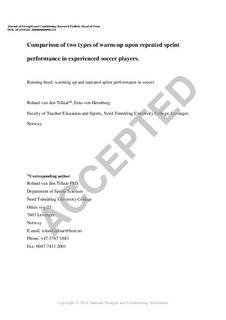Comparison of Two Types of Warm-Up Upon Repeated-Sprint Performance in Experienced Soccer Players
Journal article, Peer reviewed
Permanent lenke
http://hdl.handle.net/11250/2433492Utgivelsesdato
2016Metadata
Vis full innførselSamlinger
Originalversjon
van den Tillaar, R.J.W. & von Heimburg, E.D. (2016). Comparison of two types of warm-up upon repeated-sprint performance in experienced soccer players. Journal of Strength and Conditioning Research, 30(8), 2258-2265. doi: 10.1519/JSC.0000000000001331Sammendrag
The aim of the study was to compare the effects of a long warm-up and a short warm-up upon repeated-sprint performance in soccer players. Ten male soccer players (age, 21.9 +/- 1.9 years; body mass, 77.7 +/- 8.3 kg; body height, 1.85 +/- 0.03 m) conducted 2 types of warm-ups with 1 week in between: a long warm-up (20 minutes: LWup) and a short warm-up (10 minutes: SWup). Each warm-up was followed by a repeated-sprint test consisting of 8 x 30 m sprints with a new start every 30th second. The best sprint time, total sprinting time, and % decrease in time together with heart rate, lactate, and rate of perceived exertion (RPE) were measured. No significant differences in performance were found for the repeated-sprint test parameters (total sprint time: 35.99 +/- 1.32 seconds [LWup] and 36.12 +/- 0.96 seconds [SWup]; best sprint time: 4.32 +/- 0.13 seconds [LWup] and 4.30 +/- 0.10 seconds [SWup]; and % sprint decrease: 4.16 +/- 2.15% [LWup] and 5.02 +/- 2.07% [SWup]). No differences in lactate concentration after the warm-up and after the repeated-sprint test were found. However, RPE and heart rate were significantly higher after the long warm-up and the repeated-sprint test compared with the short warm-up. It was concluded that a short warm-up is as effective as a long warm-up for repeated sprints in soccer. Therefore, in regular training, less warm-up time is needed; the extra time could be used for important soccer skill training.
